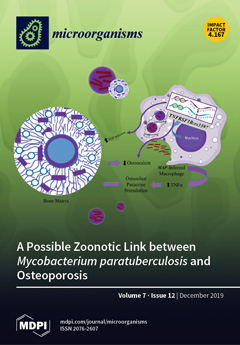Bovine mastitis is a costly disease to the dairy industry and intramammary infections (IMI) with
Staphylococcus aureus are a major cause of mastitis.
Staphylococcus aureus strains responsible for mastitis in cattle predominantly belong to ruminant-associated clonal complexes (CCs). Recognition of pathogens by bovine
[...] Read more.
Bovine mastitis is a costly disease to the dairy industry and intramammary infections (IMI) with
Staphylococcus aureus are a major cause of mastitis.
Staphylococcus aureus strains responsible for mastitis in cattle predominantly belong to ruminant-associated clonal complexes (CCs). Recognition of pathogens by bovine mammary epithelial cells (bMEC) plays a key role in activation of immune responsiveness during IMI. However, it is still largely unknown to what extent the bMEC response differs according to
S. aureus CC. The aim of this study was to determine whether ruminant-associated
S. aureus CCs differentially activate bMEC. For this purpose, the immortalized bMEC line PS was stimulated with
S. aureus mastitis isolates belonging to four different clonal complexes (CCs; CC133, CC479, CC151 and CC425) and interleukin 8 (IL-8) release was measured as indicator of activation. To validate our bMEC model, we first stimulated PS cells with genetically modified
S. aureus strains lacking (protein A, wall teichoic acid (WTA) synthesis) or expressing (capsular polysaccharide (CP) type 5 or type 8) factors expected to affect
S. aureus recognition by bMEC. The absence of functional WTA synthesis increased IL-8 release by bMEC in response to bacterial stimulation compared to wildtype. In addition, bMEC released more IL-8 after stimulation with
S. aureus expressing CP type 5 compared to CP type 8 or a strain lacking CP expression. Among the
S. aureus lineages, isolates belonging to CC133 induced a significantly stronger IL-8 release from bMEC than isolates from the other CCs, and the IL-8 response to CC479 was higher compared to CC151 and CC425. Transcription levels of IL-8, tumor necrosis factor alpha (TNFα), serum amyloid A3 (SAA3), Toll-like receptor (TLR)-2 and nuclear factor κB (NF-κB) in bMEC after bacterial stimulation tended to follow a similar pattern as IL-8 release, but there were no significant differences between the CCs. This study demonstrates a differential activation of bMEC by ruminant-associated CCs of
S. aureus, which may have implications for the severity of mastitis during IMI by
S. aureus belonging to these lineages.
Full article






